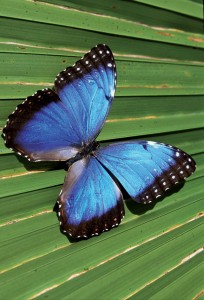They are neotropical butterflies found mostly in tropical forests in Central America and South America. There are around 80 different species of Morpho butterflies. They often provide inspiration for poets and writers who marvel at the transformation from a modest caterpillar into a magnificent butterfly.
Many morpho butterflies are coloured in metallic, shimmering shades of blue and green – in most species only the males are colourful. Their vivid, iridescent colouring is a result of the microscopic scales on the backs of their wings, which reflect light. The underside of the wings is normally a dull brown colour with many eyespots, providing camouflage against predators such as birds and insects when its wings are closed. Butterflies have two clubbed antennas, two fore wings and two hind wings , six legs and three body segments – the head, thorax and abdomen. Their diets tends to change throughout each stage of its lifecycle. As a caterpillar it chews leaves of many varieties, but generally prefers plants in the pea family. When it becomes a butterfly it can no longer chew, but drinks its food instead. Adults use a long, protruding mouthpart called a proboscis as a drinking straw to sip the juice of rotting fruit, tree sap, fungi and wet mud.
The eyes of the Morpho butterflies are thought to be highly sensitive to UV light and therefore the males are able to see each other from great distances. Some South American species are reportedly visible by the human eye up to one kilometre away. They have a very distinctive slow, bouncy flight pattern due to the wing area being enormous relative to the body size. Adults spend most of their time on the forest floor and in the lower shrubs and trees with their wings folded. However, when looking for mates, they will fly through all layers of the forest. Morphos range in wingspan from 7.5 cm to 20 cm.
They are mainly found in primary and secondary forested habitats and normally at altitudes between sea level and up to 1400 metres. Morphos are diurnal, males spend the morning patrolling along the courses of forest rivers and streams. They are territorial and will chase away any rivals. They typically live alone except for the mating season. Morphos can be very strong fliers even birds who specialise in catching butterflies on the wing find it very difficult to catch them.
The blue morpho butterfly’s wings are bright blue , edged with black and are among the largest butterflies in the world. When the blue morpho flies, the contrasting blue and dull brown colours flash, making it look like the morpho is appearing and disappearing. Blue morphos taste fruit with sensors on their legs and they scan the air with their antennae, which serve as a combined tongue and nose.
The entire life cycle of the Morpho butterfly is approximately 115 days and most of their time is spent eating and reproducing. Morphos are severely threatened by deforestation of tropical forests and habitat fragmentation. Humans provide a direct threat to this spectacular creature because their beauty attracts artists and collectors from all over the globe who wish to capture and display them.
Lloyd Boutcher,
Director Sunvil Traveller





